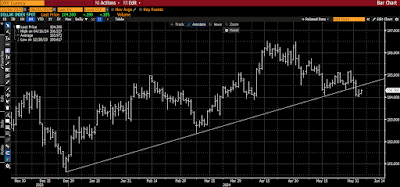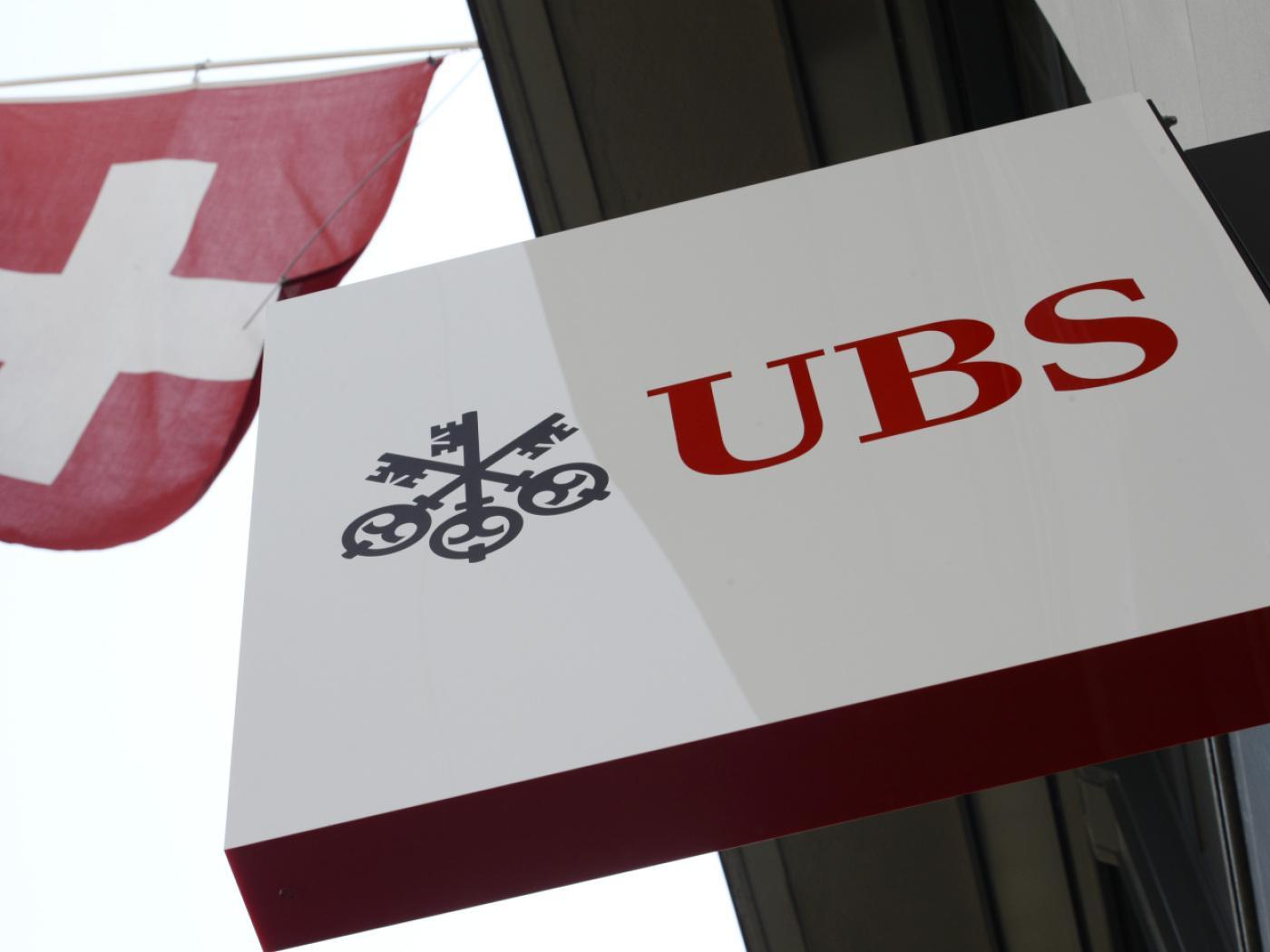Overview: The foreign exchange market is calmer today than Monday and Tuesday, and the dollar is mixed. The yen, which rallied, yesterday, has given back most of its gains and the wage data gave the market second thoughts about next week's BOJ meeting. The Mexican peso, which has been sold aggressively in the face of the strong election showing of the Morena party and allies, is the strongest currency today, though the greenback is holding above yesterday's lows. The Indian rupee is the second strongest and its stock market is recouping more than half of yesterday's steep losses. The highlight of today's North American session is the Bank of Canada meeting. The swaps market has about an 80% chance of a cut discounted. A cut today would make the Bank of Canada the third G10 central bank to cut rates (behind Switzerland and Sweden) and the first in the G7. If it does not cut rates, a move next month would likely be signaled.
Japanese, Chinese and Hong Kong stocks fell but the other large bourses in the region rose. Europe's Stoxx 600 has recouped most of yesterday's losses, which snapped a three-day advance. US index futures are firm. Asia Pacific yields fell after the sharp decline in US rates yesterday. European benchmark yields have edged up and the UK 10-year Gilt yield is up nearly four basis points. Sunak-Starmer's first debate was mixed. Sunak was seen as the winner, but Starmer was thought to be more "likeable". Gold is consolidating in a range of about $2326-$2342, inside yesterday's range. July WTI has stabilized after falling to a four-month low yesterday slightly below $72.50. It is steady today and has not been above $73.55. Europe's natgas benchmark pulled back yesterday and is a little softer today. It is below last week's settlement. US natgas prices also sold off yesterday, retracing most of Monday's gain. It is slightly firmer today and is above last week's settlement.
Asia Pacific
Japan's labor cash earnings rose by 2.1% year-over-year in April better than the 1.8% expected and the March pace was revised to 1.0% from 0.6%. What is there not to like that the yen was sold off and gave up yesterday's gains? An underlying measure that is thought to be more robust, which uses the same sample base, missed expectations of a 2.1% gain with a 1.7% increase, and the March series was revised to 1.9% from 2.2%. Still, a key challenge remains. Adjusted for inflation, cash earnings continue to fall. Real cash earnings in April for 0.7% less than a year ago. And last April, they had fallen by 3.2% year-over-year and in April 2022, real cash earnings were 1.7% lower. The data forced market participants to reassess the likelihood that next week the BOJ will slow its bond purchases, speculation of which was yen positive. Moreover, as we have argued, there is more to consumption than higher income. There are a host of other factors that make for a consumption driven society. These may include small living quarters, a greater respect for things that are not new, ostentatious consumption often looked down upon, and less eating out, for example. Still, April household spending will be reported Friday, and it is expected to have risen by 0.5% year-over-year. It would be the first positive reading since February 2023. Meanwhile, Australia reported 0.1% growth in the first quarter, a little lower than expected, though Q4 23 GDP was revised to 0.3% from 0.2%. Australia's final composite PMI stands at 52.1 after a preliminary estimate of 52.6. The average in Q1 was 51.5 and the average in April-May is about 52.4.
Falling US yields saw the greenback sold to its lowest level against the yen in nearly three weeks (~JPY154.55) yesterday. It settled below the May uptrend line (~JPY155.95). However, the dollar has bounced back today and has resurfaced above the trend line. It has reached about JPY156.30 and yesterday's high was near JPY156.50. A move, and a close above yesterday's high would be a bullish technical development. The Australian dollar traded on both sides of Monday's range yesterday, but settled within the range, which neutralized the technical signal. The Aussie has not closed outside of $0.6600-$0.6700 since May 8. It settled near the middle of the range, pleasing neither bear nor bull, and is hovering in a narrow range around the settlement today. Unlike the yen, it has not been punished for disappointing data. The PBOC set the dollar's reference rate at CNY7.1097 (CNY7.1083 Tuesday). The average in Bloomberg's survey was CNY7.2421 (CNY7.2295 Tuesday. The dollar fell to two-week lows against the offshore yuan (~CNH7.2415) and has recovered to almost CNH7.2565 today. The rolling 30-day correlation between changes dollar against the offshore yuan and US 10-year yields is near the high for the year, above 0.50. The yen, as is widely recognized is also sensitive (correlated) with US yields. The 30-day correlation of changes in the dollar-yen and dollar-offshore yuan is slightly below 0.80, the highest since 2016.
Europe
With the ECB meeting tomorrow, today's final PMI reading is not the focus. Still, the new information came primarily from Spain and Italy, for whom this is no preliminary estimate. For the record, the Germany's final PMI was revised higher, and the France's was shaved. Italy's disappointed but the composite at 52.3 (52.6 in April) is still firm. Spain's was even better, beating expectations with a 56.9 reading (56.2 in April). The UK's final composite PMI was boosted by the improved manufacturing PMI (services was unchanged) and stands at 53.0 (52.8 in April). An ECB rate cut tomorrow is nearly a foregone conclusion, with even many of the hawks seemingly endorsing it. The forward guidance is important, and maybe even decisive, for the markets' reaction. There are two channels in which the forward guidance will be delivered. One is President Lagarde's press conference following meeting. She will likely downplay the move as an easing of financial conditions. Instead, she may borrow the language from the ECB's Chief Economist Lane and talk about removing some of the restrictiveness of policy but that it needs to remain restrictive. She may also warn against speculation about timing of the next cut and avoid using word cues to suggest another near-term cut. The second channel are the ECB's staff forecasts. Growth may be revised higher (from 0.6%), and inflation (from 2.3%) lower this year. In March, it also forecast growth next year at 1.5% and CPI at 2.0%. Leaving these untouched would be consistent with this week's rate cut an adjustment rather than a course change, though it is (like Galileo saying "but it still moves).
Although the euro was sold above $1.09, the pullback was modest. The single currency settled its third-highest level since March 20, which still seems strong given the ECB meeting tomorrow and the US jobs data on Friday. The euro found bid in European and US mornings near $1.0860 but was not able to resurface above $1.0885 in North America. It remains in an exceptionally narrow range today (~$1.0870-$1.0885). Sterling performed similarly. It was sold in Asia Pacific trading on Tuesday above $1.28 and it fell around $1.2745 before the North American open and rose back to almost $1.28. It settled at its second-highest level since March 20. Monday's close above $1.28 was the highest. It, too, is stuck in a narrow range today (~$1.2765-$1.2785). We are still suspicious that these gains in the euro and sterling can be sustained, given the uptrend since the mid-April and the over-extended momentum indicators. Still, the price action needs to be respected. A move below $1.0785 in the euro and close $1.2675 for sterling is needed to suggest a top is in place.
America
>The US monthly jobs report
rivals the CPI for market interest, and following yesterday's
softer-than-expected JOLTS report, today is the ADP estimate. It is not, and is not meant to be, a lead
indicator for the BLS estimate of the change in the private sector employment.
Still, some economists will adjust their forecast on today's report, or some
observers will simply talk about a "whisper number", typically
generated by traders and other market participants rather than economists'
formal forecast. Today, we suspect it will be overshadowed not by the final
PMI, but by the services ISM. Its first sub-50 print since the end of 2022 in
April sent the greenback lower. However, April seemed to overstate the slowdown
in the US economy and most May survey data has shown sequential improvement.
Not so with the ISM manufacturing survey reported Monday (48.7 vs. 49.2). The
median forecast in Bloomberg's survey has the ISM services rising to 51.0, with
the contraction in employment slowing and new orders growing at a faster pace.
Shortly before the ISM is reported, the Bank of Canada meeting concludes. The
market sees a greater chance of a cut following last week's disappointing Q1
GDP (and flat March), which comes on the heels of softer than expected April
CPI (headline and core readings). The swaps market has about an 80% chance of a
cut discounted, which would bring the target rate to 4.75%. Before the CPI
report, the market had slightly less than a 45% of a cut, and before the Q1
GDP, the odds were around 65%. The next cut is fully discounted for Q4, though
there is about a 70% chance priced in for September. The failure to cut today
could spur a quick bounce in the Canadian dollar, but we expect it to be
short-lived. 
Since the end of April, the US dollar has
chopped between CAD1.36 and CAD1.3750. Several intraday breaks have occurred, but not
on a settlement basis. The greenback's test on the lower end of the range on
Monday was rebuffed and the greenback returned to CAD1.37 area. We note that
the rolling 30- and 60-day correlations of the changes in the exchange rate and
the Dollar Index are over 0.80, among the highest in more than a decade. And
the Dollar Index broke below the trendline connecting the low for late last
year, the early March low, and the mid- and late May lows Monday and remained below
it yesterday. It is found near 104.50 today. At its best yesterday, the
dollar approached MXN18.20. This is roughly four-standard deviations
above the 20-day moving average. It settled last week slightly above MXN17.00.
Although the dollar pulled back, it found support near MXN17.70. Still, the
dollar closed above Monday's high (~MXN17.7475). Although, the peso did not
stabilize, Mexican stocks did. The Bolsa plummeted by 6.1% Monday and recouped
almost half of it yesterday. Mexico's Finance Minister de la O, who will remain
at the post under Sheinbaum, tried to reassure investors that debt will be
reduced, and the independence of the central bank will be respected. The
peso has stabilized today. The US dollar has returned to nearly MXN17.6050. Yesterday's
low was near MXN17.5460.
Tags: #USD,Australia,Bank of Canada,Currency Movement,ECB,Featured,Japan,Mexico,newsletter,US





























